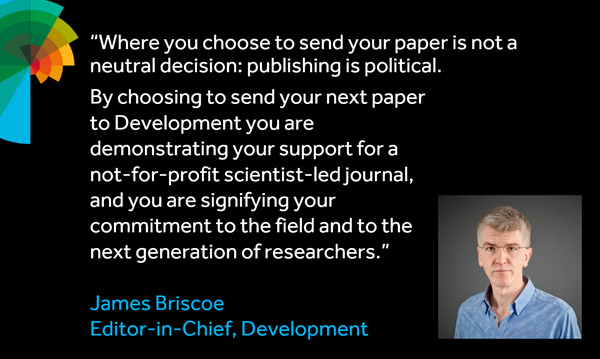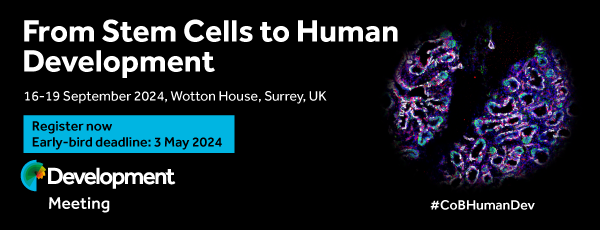Issues
-
Cover image
Cover Image

Cover: E16 mouse lung showing expression of Hopx (white, alveolar type I cell marker), Sftpc (green, alveolar type II cell marker) and Tgfbi (red, myofibroblast marker) by RNA in situ hybridization (blue, DAPI marking nuclei). During the canalicular stage of lung development, Sftpc+ early alveolar type II cells demonstrate distinctly spatial separation from Hopx+ early alveolar type I cells and adjacent Tgfbi+ myofibroblasts, suggesting early fate commitment of the epithelium. See Research article by Negretti et al. (dev199512)
- PDF Icon PDF LinkTable of contents
- PDF Icon PDF LinkIssue info
RESEARCH HIGHLIGHTS
DEVELOPMENTAL TWISTS
INTERVIEWS
SPOTLIGHT
The zebrafish issue: 25 years on
Summary: In this Spotlight, five zebrafish researchers reflect on how the 1996 zebrafish issue of Development has influenced their career and their community.
REVIEW
Sculpting with stem cells: how models of embryo development take shape
Summary:In vitro engineering of embryo-like structures (stembryos) from pluripotent stem cells offers unique possibilities to understand how boundary conditions that impose geometrical, mechanical and biochemical constraints pattern and shape the mammalian embryo.
STEM CELLS AND REGENERATION
Flower meristem maintenance by TILLERS ABSENT 1 is essential for ovule development in rice
Summary:TAB1 is identified as a central factor that promotes ovule development in rice by regulating stem cell maintenance at a later stage of flower development.
RESEARCH REPORTS
A stop or go switch: glycogen synthase kinase 3β phosphorylation of the kinesin 1 motor domain at Ser314 halts motility without detaching from microtubules
Summary: GSK3β-mediated phosphorylation of kinesin 1 heavy chain is essential for kinesin 1 motility, cargo/membrane attachment and ATPase activity, but not for microtubule binding.
DPPA2 and DPPA4 are dispensable for mouse zygotic genome activation and pre-implantation development
Highlighted Article: Although DPPA2 and DPPA4 are essential for activating two-cell embryo-specific transcripts in mouse embryonic stem cells, they are dispensable for mouse zygotic genome activation and pre-implantation development.
RESEARCH ARTICLES
Molecular mechanisms of embryonic tail development in the self-fertilizing mangrove killifish Kryptolebias marmoratus
Summary: The mangrove killifish, a self-fertilizing vertebrate model, allows rapid identification of the mutated genes noto and msgn1 from mutant strains and their genetic roles in tail bud development.
Maternal Smc3 protects the integrity of the zygotic genome through DNA replication and mitosis
Summary: This study demonstrates at the molecular level how maternally provided SMC3 supports the first round of DNA replication and chromosome segregation in the zygote to enable successful embryogenesis.
A single-cell resolved cell-cell communication model explains lineage commitment in hematopoiesis
Highlighted Article: Through theory and computational modeling, cell-cell communication is revealed to be a crucial and under-appreciated determinant of cell-fate decision-making during hematopoiesis.
Maternal Dppa2 and Dppa4 are dispensable for zygotic genome activation but important for offspring survival
Highlighted Article: Conditional knockout mouse models reveal maternal stores of Dppa2 and Dppa4 are dispensable for zygotic genome activation, contrasting findings in embryonic stem cells. However, both maternal and zygotic Dppa2/4 are required for development.
Generation and timing of graded responses to morphogen gradients
Summary: Morphogen gradients are known to subdivide a naive cell field into distinct zones of gene expression, but morphogens can also induce a graded response within such domains.
Translation-dependent mRNA localization to Caenorhabditis elegans adherens junctions
Highlighted Article: An smFISH-based survey identifies a subset of mRNAs encoding junctional components that localize at or in proximity to the adherens junction through a translation-dependent mechanism.
The microRNA miR-202 prevents precocious spermatogonial differentiation and meiotic initiation during mouse spermatogenesis
Summary: The microRNA miR-202 prevents precocious spermatogonial differentiation and meiotic initiation during mouse spermatogenesis and acts together with DMRT6 and STRA8 as a module in the meiotic initiation regulatory network.
KATNB1 is a master regulator of multiple katanin enzymes in male meiosis and haploid germ cell development
Summary: Analysis of a graded series of KATNB1 loss-of-function models reveals that katanin proteins are required to regulate the vast majority of microtubule-based processes in male germ cell development.
Frazzled/Dcc acts independently of Netrin to promote germline survival during Drosophila oogenesis
Summary: Frazzled is required in the Drosophila female germline for the progression of egg chambers through mid-oogenesis, regulating germline survival by inhibiting apoptosis.
TECHNIQUES AND RESOURCES
Intermediate progenitor cells provide a transition between hematopoietic progenitors and their differentiated descendants
Highlighted Article: Intermediate progenitor cells are a distinct population of multipotent cells that contribute to all three differentiated blood cell types in Drosophila and act as signaling centers to neighboring cells.
A single-cell atlas of mouse lung development
Summary: Time-series single-cell transcriptomic analysis identifies previously unrecognized transitional states, population dynamics, fate trajectories and gene-expression evolution in the developing mouse lung.
CORRECTION
Correction: The histone acetyltransferase HBO1 promotes efficient tip cell sprouting during angiogenesis
Call for papers: Uncovering Developmental Diversity

Development invites you to submit your latest research to our upcoming special issue: Uncovering Developmental Diversity. This issue will be coordinated by our academic Editor Cassandra Extavour (Harvard University, USA) alongside two Guest Editors: Liam Dolan (Gregor Mendel Institute of Molecular Plant Biology, Austria) and Karen Sears (University of California Los Angeles, USA).
Choose Development in 2024

In this Editorial, Development Editor-in-Chief James Briscoe and Executive Editor Katherine Brown explain how you support your community by publishing in Development and how the journal champions serious science, community connections and progressive publishing.
Journal Meeting: From Stem Cells to Human Development

Register now for the 2024 Development Journal Meeting From Stem Cells to Human Development. Early-bird registration deadline: 3 May. Abstract submission deadline: 21 June.
Pluripotency of a founding field: rebranding developmental biology

This collaborative Perspective, the result of a workshop held in 2023, proposes a set of community actions to increase the visibility of the developmental biology field. The authors make recommendations for new funding streams, frameworks for collaborations and mechanisms by which members of the community can promote themselves and their research.
Read & Publish Open Access publishing: what authors say

We have had great feedback from authors who have benefitted from our Read & Publish agreement with their institution and have been able to publish Open Access with us without paying an APC. Read what they had to say.



